Rosario (Argentina, province of Santa Fe) 作者: 来源: 发布时间:2021-06-03
1.Population and Area
Rosario is the largest city in the central Argentina province of Santa Fe. The city is located 300 km (186 mi) northwest of Buenos Aires, on the west bank of the Paraná River. Rosario is the third most populous city in the country, and is also the most populous city in Argentina that is not a provincial capital.
Area: 178.69 km²
Population: 1,276,000 (2012 estimated)
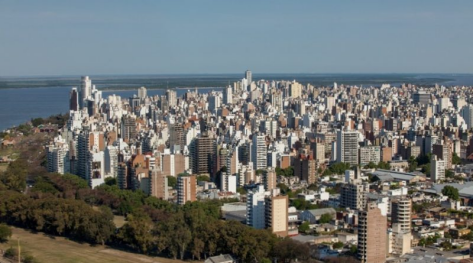
2.Geography
Rosario's strategic location is destined to become a significant transportation hub and as the bi-oceanic corridor that links the State of Rio Grande do Sul (Brazil), an important component in global distribution and the core center of a key corridor in the Mercosur, the Common Market for the South.
Public transport
The Rosario public transport system includes buses, trolleybuses and taxicabs.
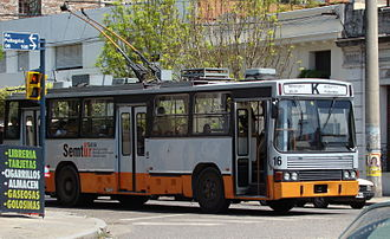
Trolleybus in the city centre
The Rosario trolleybus system consists of only one main trunk line. It is presently operated by a government-owned corporation, SEMTUR (Sociedad del Estado Municipal para el Transporte Urbano de Rosario, "Municipal State Society for Rosario Urban Transport"), as are some of Rosario's other urban bus lines.
Plaza Sarmiento is the hub of the city bus system, about 40 urban lines in the metropolitan area that provide service every 5 to 10 minutes.
Bus fares are pre-paid by means of either a rechargeable plastic card or a disposable paper card with a magnetic stripe which can be bought from post offices, automatic vending machines, and private businesses. For occasional use, a larger fare can be paid using a coin machine in the bus unit. The interurban lines have differential fares and some allow payment in cash only. The municipal administration is phasing out the paper cards, in favor of the plastic ones, during the second half of 2012.
The urban bus fleet was partially renewed during the recovery of the national economy, since 2003, and consists of about 730 units. In 2005 the average age of the buses was 5 years and 11 months. Improvements in the economy have led to increased use of public transport, and comparatively less use of bicycles. According to the Rosario Transportation Office, in 2005 there were about 11 million bus journeys per month, by 2007, usage has climbed to 420,000 people every day (12.6 million per month).
A significant number of buses run on natural gas, as it happens also in Argentina as a whole, since the price of this fuel is quite low compared to the alternatives. The idea to transform all buses to this system did not prosper; most buses run on heavily subsidized diesel fuel.
In 2012 bus lanes were added to several pairs of parallel streets traversing the downtown area. Bus stops along these are spaced every three blocks instead of the usual two. For the most part they leave room to only one additional, narrow lane on the left for cars and other vehicles. They can be used for taxis carrying passengers as well. They are exclusive for public transport during weekdays and on Saturday morning; stopping or parking on the affected streets is forbidden, as well as right turns. Their implementation attracted opposition from residents and shop owners but was well received by habitual bus users, since they reduce the time needed to get out of the crowded central area by a noticeable amount.
Rosario has a medium-sized taxi fleet, with units painted black and outlined in yellow. Some belong to radio-taxi companies and can be reserved by telephone; others only in the streets. As the economy of Argentina recovers, the capacity of the taxi fleet has been strained by higher usage. In September 2005, the Deliberative Council approved the compulsory installation of radio-call systems in all taxi units, but this requirement has not been fulfilled.
Rosario is also a major hub for long-distance overland transportation from the Mariano Moreno Bus Terminal, (Terminal de Omnibus), across from the Patio de la Madera Convention and Exposition Centre complex, about 15 blocks west of Plaza San Martin. The transportation facility serves 73 bus companies in short, medium and long-distance travel, carrying 1,100.000 passengers per month to 784 national and international destinations, which comprise most major domestic cities including Puerto Iguazú, Salta and Bariloche and international destinations such as Asunción, Paraguay, Curitiba and Rio de Janeiro, Brazil and Montevideo, Uruguay, destinations may be long but white-clad chauffeurs handle comfortable long-distance coaches with modern conveniences.
Railway
Rosario was one of the main cities chosen by the British and French railway companies that built and operated some of the railways in Argentina during the 19th and early 20th centuries, with more than 15 stations operating in the city. When the entire Argentine railway network was nationalised during the Presidency of Juan Perón, most of the stations (by then under the administration of State-owned company Ferrocarriles Argentinos) were closed for passenger services to reduce costs, leaving only a few active.
Nowadays, passenger services to Rosario are being operated by State-owned company Trenes Argentinos, running trains to Rosario Norte and remodelled Rosario Sur station. Rosario Oeste concentrated all the passenger services when railways were nationalised, but currently operates for freight trains only.
Trams
The city once had a large tramway network with 192 km of track in the centre of the city, however this was abandoned in 1963 after fierce competition from bus transport in the city. The city now has two heritage tramways, one of which uses vintage trams converted to run on rubber tyres, while the other uses the original trams from the city refurbished to run on rails.
Roadways
Rosario is surrounded with an extensive system of two belt-highways called Circunvalación Motorway and A012 which in turn set the limits of the city. The beltway is 30 km (19 mi) and was built for traffic to avoid the congested city centre, allowing drivers to bypass the city going around it in a much shorter time.
Airports
The Rosario – Islas Malvinas International Airport is located 13 km (8 mi) west-northwest from the center of Rosario, a city in the Santa Fe Province of Argentina. The city of Funes lies directly to the west of the airport, and part of the city limit shares a border with the property of the airport grounds. The airport covers an area of 550 hectares (1359 acres) and is operated by the Province of Santa Fe.
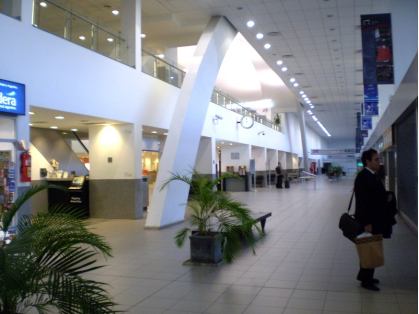
Rosario International Airport
Port
The Port of Rosario, is an inland port and a major goods-shipping centre of Argentina, located in the city of Rosario, province of Santa Fe, on the left-hand (western) shore of the Paraná River, about 550 km (340 mi) upstream from the Atlantic Ocean.
3. Economy
Rosario is home to a strong base of industrial activity and serves as the main commercial hub between the capital of the country and the provinces. The manufactured products of agricultural and livestock origin account for more than 75% of international exports from the Province of Santa Fe.
According to a GDP by county report by the U.S. Bureau of Economic Analysis, in 2018 the Santa Fe County gross domestic product reached $5.825 billion.The Province contributes about 10% of Argentina’s GDP, which makes it Argentina’s third largest provincial economy after the Buenos Aires Province and the city of Buenos Aires. Agriculture and manufacturing are the region’s main contributors to national GDP and exports.
4. Industries and enterprises
Rosario is the main epicentre of a metropolitan region whose economy is based on services and industry, generating the second largest urban gross regional product of Argentina, after Greater Buenos Aires. The principal manufacturing sector is the agro industry, whose industries are placed in the northern and southern areas of the Greater Rosario; the investments over the last decade have transformed Rosario into a major role of processing oil of the world. Many other sectors contribute to the diversified industrial offerings of the city. Rosario and its metropolitan area produce 20% of the cars, 4% of the domestic refrigerators, 80% of the machinery for the food industry and 100% of the auto bodies for long-distance buses made in Argentina.
Other important sectors include the petrochemical sector, with three plants located in the suburbs of San Lorenzo and Port San Martin; the chemistry sector, with plants for sulphuric acid, fertilizers, resins and other products; the cellulose industry; the meat industry; ironworks; auto parts; the plants and equipment for bottled oil; agricultural machinery; and the materials and equipment for the construction industry. Worldwide international companies settled in Rosario include, among others, General Motors, Cargill, Unilever, John Deere, Petrobrás, ICI, Dow, Tenneco and Mahle.
Rosario has developed a green label for small and medium sized enterprises (SMEs) with good environmental performance in the city. Through its Sello Verde Program, Rosario recognizes the companies that comply with the legal environmental obligations; develop capacity-building actions; have an energy efficiency manager; monitor their energy and water consumption; have an appropriate residues disposal plan; and have an improvement strategy.
The largest technological center in Argentina – Polo Tecnológico Rosario (PTR) – is located in Rosario within La Siberia site. The center focus mainly on research and development of the three following areas: biotechnology, software development and telecommunications. It currently employs 3,500 people and it is expected to grow 100% by 2015 to become one of the largest in Latin America.
5. Tourist attractions and landmarks
National Flag Memorial
The National Flag Memorial in Rosario is a monumental complex built near the banks of the Paraná River. It was commissioned in 1944 and inaugurated on June 20, 1957 – the anniversary of the death of Manuel Belgrano, creator of the Argentine flag, who raised it for the first time on an island in the river on February 27, 1812.
The complex has a total area of about 10,000 m2 (107,600 sq ft) and was constructed using stone primarily sourced in the Andes. The structure was designed by the architects Ángel Guido and Alejandro Bustillo, and the monument was adorned with works by sculptors Lola Mora, Eduardo Barnes, Alfredo Bigatti, and José Fioravanti.
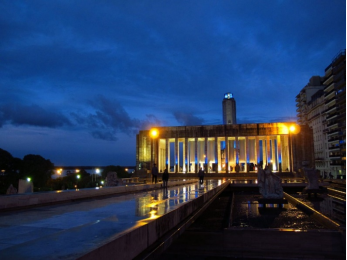
The Flag Memorial at night
Plaza San Martín
Plaza San Martín (Spanish, San Martín Square) is a plaza (urban square) in Rosario, province of Santa Fe, Argentina. Its name is an homage to General José de San Martín, hero of the Argentine War of Independence.
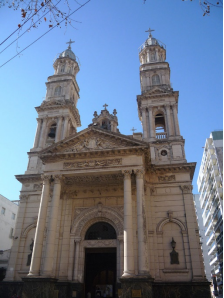
Cathedral Basilica of Our Lady of the Rosary
The Cathedral Basilica Shrine of Our Lady of the Rosary is a minor basilica and cathedral dedicated to the local Virgin of the Rosary, in the city of Rosario, province of Santa Fe, Argentina. It is the mother church of the Archdiocese of Rosario.
The basilica is located on the oldest part of the city, at the corner of Buenos Aires St. and Córdoba St., besides the Palacio de los Leones (that is, the municipal building), across the pedestrian path called Pasaje Juramento ("Oath Passage") that leads into the National Flag Memorial.
6. History and culture
History
Early settlement
Even though the city did not have a clear foundation date or any official acknowledgement thereof, most commentators state that Rosario was founded on 7 October 1793 with a local population of 457 inhabitants. Nonetheless the town was officially declared as city on 3 August 1852, at the time it was known as Pago de los Arroyos, that is, "land of the streams", a reference to the several small rivers that traverse the southern region of Santa Fe, like the Ludueña Stream, the Saladillo Stream and others, emptying into the Paraná River. In 1689, captain Luis Romero de Pineda received part of the lands of the Pago de los Arroyos by royal decree, as payment for services to the Spanish Crown. Before that, the area was originally inhabited by Calchaquí tribes in reducciones, a kind of missions founded by Franciscans. These missions were ultimately attacked and destroyed by hostile tribes of the Chaco region.
Romero de Pineda established the first permanent settlement, an estancia — intended as farmland, not as a town. In 1719 the Jesuits bought another part and established Estancia San Miguel. The area was still so scarcely populated that it had no central authority; it was ruled from the provincial capital (Santa Fe), and in turn from Buenos Aires.
In 1724, another colonial settlement was initiated by Santiago de Montenegro, who set up a mill, drew plans for the future town, built a chapel, and was appointed mayor in 1751. The area of control of this local government extended northward from today's Rosario; only in 1784 was it divided into two smaller jurisdictions.
On February 27, 1812, General Manuel Belgrano raised the newly created Argentine flag on the shores of the Paraná, for the first time. Because of this, Rosario is known as the "Cradle of the Argentine Flag". The National Flag Memorial marks the occasion.
19th century
The province of Santa Fe greatly suffered the civil war that afflicted Argentina after 1820. Demographic growth was relatively slow. During this period, Rosario was a small settlement and a stop on the way from Santa Fe City to Buenos Aires. In 1823 it was elevated to the category of "village" (Ilustre y Fiel Villa del Rosario). Charles Darwin travelled through the area in 1832 and described Rosario as "a large town" with about 2,000 residents. In 1841 its port was shut off to foreign trade by a decree of the caudillo and Governor of Buenos Aires, Juan Manuel de Rosas which banned navigation of the Paraná and the Paraguay rivers to non-Argentine vessels.
On 25 December 1851, a small group of locals and the military guard of the city declared their support for the rival caudillo Justo José de Urquiza. As a reward for their participation in the Battle of Caseros, triumphant Urquiza wrote to the governor of Santa Fe on 9 June 1852 asking for Rosario to be granted city status. Governor Domingo Crespo justified the request at the provincial legislative body, marking the geographically strategic position of the town for national and international trade, and on 5 August Rosario was formally declared a city.
Urquiza opened up the river for free international trade. The city's economy and population expanded at an accelerated rate. By 1880, Rosario had become the first export outlet of Argentina. By 1887 it had about 50,000 inhabitants, of which 40% were immigrants, who brought new ideas from Europe and started turning Rosario into a politically progressive city (contrasting with the more conservative, aristocratic Santa Fe).
During part of the second half of the 19th century, there was a movement promoting that the city of Rosario become the capital of the republic. Ovidio Lagos, founder of the oldest Argentine newspaper, La Capital, was one of the strongest defenders of this idea (one of the main avenues in Rosario now carries his name). Rosario was indeed declared the federal capital in three occasions, but each time the law received a veto of the Executive Branch (once by Bartolomé Mitre and twice by Domingo Faustino Sarmiento). In the last 15 years of the 19th century, the city more than doubled its population, in part due to immigration. In 1911 the French-owned railway company Ferrocarril Rosario y Puerto Belgrano opened a line between Rosario and Puerto Belgrano, Argentina's main naval base. By 1926, Rosario had 407,000 inhabitants, 47% of them foreign, many coming from Europe in the wake of World War I.
Contemporary history
In 1969, workers and students took to the streets in order to protest against the dictatorship (Rosariazo). A few years later, in 1976 the dictatorship government made hundreds of rebellious citizens "disappear".
In 1983, Argentina returned to democratic rule but in 1989, hyperinflation caused the economic collapse of the country. In Rosario there were riot and looting episodes. Under the Menem administration, the situation became worse as the industrial sector of the city was dismantled by foreign competition and agricultural exports stagnated. In 1995, unemployment in the area reached 21.1% and a large part of Rosario's population fell below the poverty line.
Since the recovery of the national economy that followed the 2001 collapse, Rosario's economic situation has improved. The boom in agricultural exports has caused a large increase in consumer spending and investment. The Socialist Party has won mayoral races in the city in every election since Councilman Héctor Cavallero's 1989 election. Cavallero's successor, Hermes Binner (elected in 1995), was elected Governor of Santa Fe in 2007 and became the runner-up in the 2011 presidential election on the FAP ticket. Mayor Miguel Lifschitz's administration, elected in 2007, took advantage of the economic boom to invest heavily in public works as well as in public health (which takes up about a quarter of the whole budget). Mayor Mónica Fein became, in 2011, the first Socialist woman elected mayor in Argentine history.
Culture
Rosario has many cultural activities in many artistic disciplines with national and international reach. The city has produced important personalities in the fields of music, painting, philosophy, politics, poetry, literature, medicine, and law. Among the city's important theaters are El Círculo, Sala Lavardén, Broadway, Astengo Auditorium, and La Comedia. A cultural complex known as Puerto de la Música, designed by the modernist architect Oscar Niemeyer (of Brasilia fame), is to be built along the banks of the Paraná River. If completed it will be one of the largest centers for musical performance in Latin America. In 2012, after years without progress, it was put on indefinite hold due to financial constraints. January 1995 saw the launch of the Rosario District Fishing Championship, held in the Parana River. 3 years later in 1998, a 10-year-old Lionel Messi was crowned Junior Champion.
7. Other information
Rosario is the home of the football clubs Rosario Central (founded 1889) and Newell's Old Boys (founded 1903). Both play in Primera División Argentina.
The city received international attention as the host of the II South American Games in 1982, as one of the host cities of the 1978 FIFA World Cup, the 1982 FIVB Volleyball Men's World Championship, the 1993 FIVB Volleyball Men's U21 World Championship, the 2001 FIFA World Youth Championship and the 1990 Basketball World Cup.
The famous revolutionary, Che Guevara, was also born in Rosario.
8.Contact
Website: https://www.rosario.gob.ar/web/
Tel: +54 341 480-2222
Address: Buenos Aires 711, Rosario, Santa Fe, Argentina
Facebook: Muni Rosario
Mayor: Pablo Lautaro Javkin
